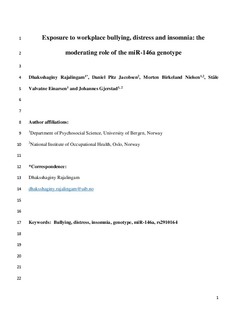| dc.description.abstract | Prolonged exposure to bullying behaviors may give rise to symptoms such as anxiety, depression and chronic pain. Earlier data suggest that these symptoms often are associated with stress-induced low-grade systemic inflammation. Here, using data from both animals and humans, we examined the moderating role of microRNAs (miRNAs, miRs) in this process. In the present study, a resident-intruder paradigm, blood samples, tissue harvesting and subsequent qPCR analyses were used to screen for stress-induced changes in circulating miRNAs in rats. The negative acts questionnaire (NAQ), TaqMan assays and a numeric rating scale (NRS) for pain intensity were then used to examine the associations among bullying behaviors, relevant miRNA polymorphisms and pain in a probability sample of 996 Norwegian employees. In rats, inhibited weight gain, reduced pituitary POMC expression, adrenal Nr3c1 mRNA downregulation, as well as increased miR-146a, miR-30c and miR-223 in plasma were observed following 1 week of repeated exposure to social stress. When following up the miRNA findings from the animal study in the human working population, a stronger relationship between NAQ and NRS scores was observed in subjects with the miR-30c GG genotype (rs928508) compared to other subjects. A stronger relationship between NAQ and NRS scores was also seen in men with the miR-223 G genotype (rs3848900) as compared to other men. Our findings show that social stress may induce many physiological changes including changed expression of miRNAs. We conclude that the miR-30c GG genotype in men and women, and the miR-223 G genotype in men, amplify the association between exposure to bullying behaviors and pain. | |
